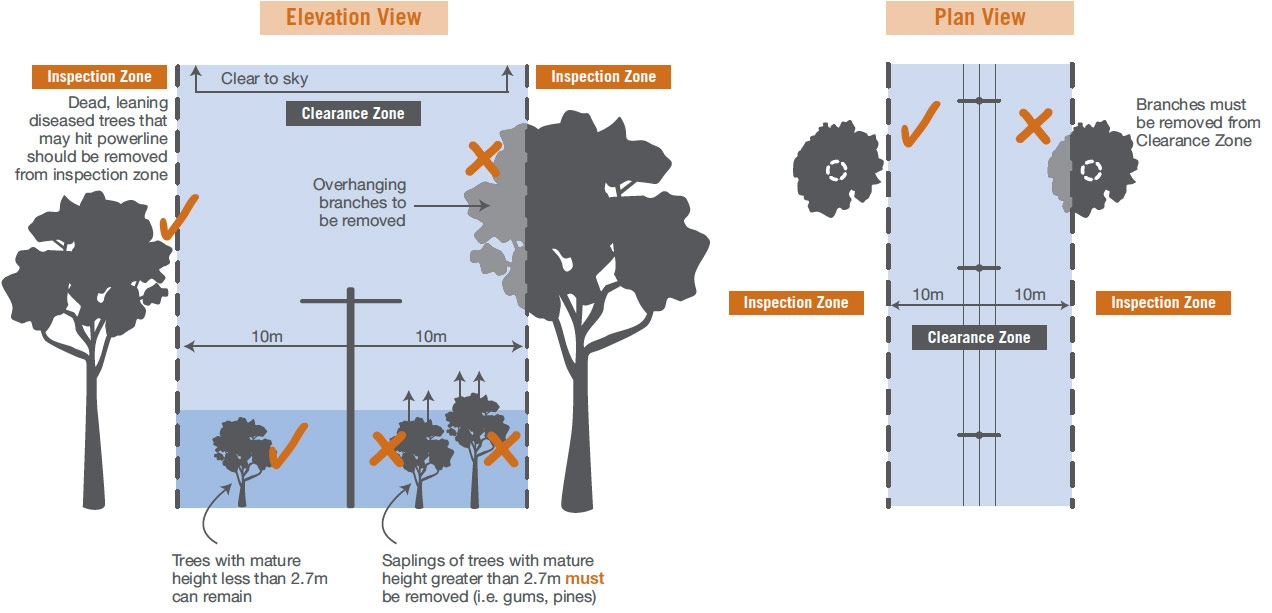We have more than 20,000 customers with private overhead electric lines across our networks.
Private overhead electric lines, or POELs can be a combination of privately owned poles and lines, or just a section of line, that support rural properties and their various buildings.
If you have a POEL, it is your responsibility to make sure it’s in safe working condition.
Each year, we send out a reminder to all POEL owners about their responsibilities, electrical safety, and disconnection advice.
We inspect private electric lines every three years to make sure they are in a serviceable condition. If we find a problem, we will issue a defect notice on the POEL, which requires the customer to ensure the fault is fixed by a specified date.
A Registered Electrical Contractor is the only person who can carry out any work on a POEL. Similarly, if a customer needs to trim vegetation around a POEL, we recommend a qualified contractor is engaged.
POEL Documents and Resources
Undergrounding private lines
Unless alternative compliance applies, undergrounding private powerlines is mandatory if:
- More than 20 per cent of the poles, spans of cable or wires need to be repaired or replaced
- The line is in a Hazardous Bushfire Risk Area, as declared by the Country Fire Authority
If your line is to be placed underground, your Registered Electrical Contractor will need to set up a new point of supply in consultation with us. A new point of supply may also require an underground service pit.
To request a new point of supply, please apply via mySupply
If you would like to speak to our Customer Requests Team, please call 1800 771 434 during business hours.
Vegetation clearances
Did you know, plants and trees are one of the main causes of fires and faults around powerlines? That’s why it’s important vegetation is always at a safe clearance from lines.
If you’ve requested the installation of a powerline extension to your property, or already have one, it’s your responsibility to keep them clear.
Keeping your POEL clear of vegetation is not included in any Connection Contract you may have entered with us. This means any tree clearing, stump or debris removal required along the route of a proposed powerline will be at your own expense.
You will need to check the line annually to ensure clearances are being maintained and arrange trimming or cutting when vegetation becomes overgrown.
When this work is complete, then please submit the following forms to confirm your compliance with vegetation management obligations.
Please keep the powerline easement clear of fallen leaves and branches. Be aware that if you intend to burn this debris, you will need shire/council and/or fire authority approval. Do not stack and burn debris directly beneath powerlines.
For advice relating to vegetation management, please call us on the number below. We will be happy to assist you.
CitiPower: 1300 301 101
Powercor: 13 22 06
New powerline clearances
You will need to clear all vegetation from the new powerline easement at least 10 working days prior to the scheduled installation date or as agreed with us.
The typical clearance applied to new, high-voltage powerlines is a 20 metre clearance corridor – being 10 metres on each side of the proposed powerline. All vegetation clearances must follow the “Powerline Clearance Standard for New Overhead Powerlines”. Examples of Powercor tree clearance requirements are shown below.
Network approval
We will confirm all vegetation clearance works meet all requirements before approving the construction of a new powerline.
It is important that you do not begin clearing vegetation until you have:
- Confirmed the final route of the proposed electricity line with CitiPower or Powercor
- Determined the appropriate vegetation clearance distances required to be set up for your specific powerline route and design
- Obtained all necessary approvals from your local council or shire, the Department of Environment, Land, Water and Planning, and any other approval bodies that apply regulations in your area

Typical vegetation clearance for new, high-voltage powerlines – rural areas
This standard is based on the “The Electricity Safety (Electric Line Clearance) Regulations” and includes added clearances to account for regrowth into the clearance space between future Powercor pruning programs.
These distances may be increased or reduced based on a technical assessment by Powercor and confirmed in the final approved powerline design. Factors considered in this assessment include the length of extra-long spans, proximity of commercial tree plantations, location of additional poles, and the use of insulating conductor.
Immature trees of species growing taller than four metres (such as acacias or eucalypts) must be removed from the clearance area. Foliage spraying with a herbicide is acceptable for low level scrub.
Where trees are removed, stumps must be removed or cut flush to ground level and treated with herbicide to prevent regrowth. This ensures safe and unrestricted vehicle access by Powercor and emergency services vehicles and minimises the potential for tyre damage.
Vegetation management
Permit conditions often apply to removing vegetation from private property. They also apply if native vegetation or trees need to be removed on road reserves or crown land to support your POEL.
In these cases, we recommend you contact your local shire or council and follow their permit and consent requirements. Your local government may also send your application to other responsible authorities such as the Victorian Department of Environment, Land, Water and Planning.
Once you have these permits, make sure any tree clearing on roadsides and public land is undertaken by qualified and insured contractors.
We recommend professionals be used for the safe trimming and removal of trees.
And if you’re thinking about revegetating any areas in or around the powerline easement, then check our guide on the species of plants which will grow safely near overhead lines and outside clearances.
Looking for something else in
For your home
Explore another page







